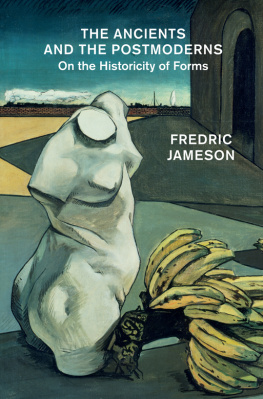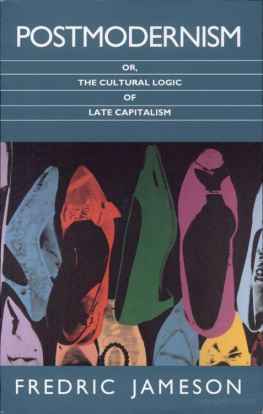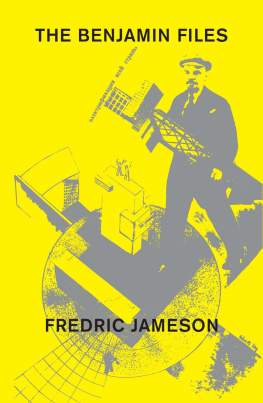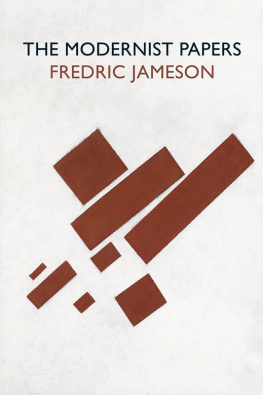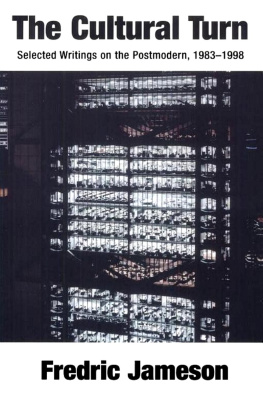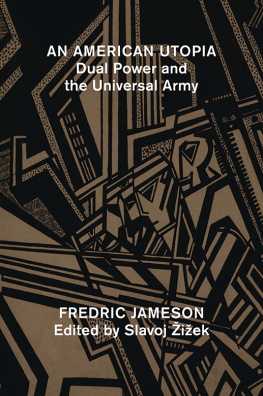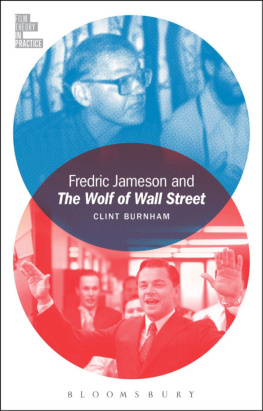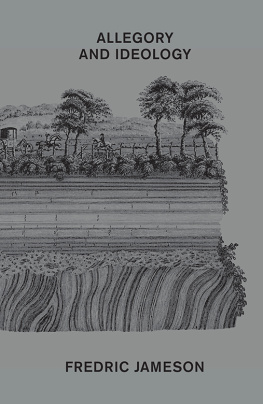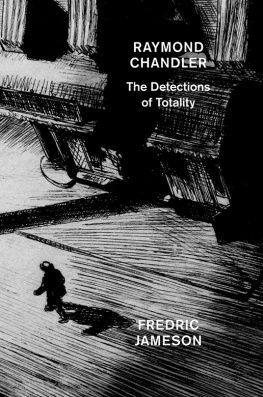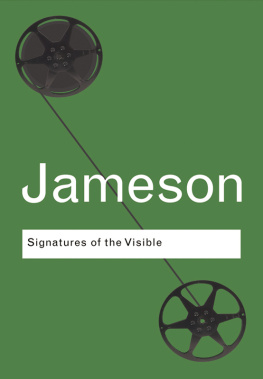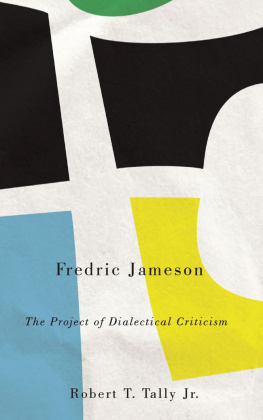THE ANCIENTS AND THE
POSTMODERNS

FREDRIC JAMESON

First published by Verso Books 2015
Fredric Jameson 2015
Author and publisher would like to acknowledge the prior appearance of earlier versions of certain chapters in the following publications: Chapter 2, Modernist Cultures 8: 11 (2013); Chapter 4, Andrew Horton, ed., The Last Modernist: The Films of Theo Angelopolous (Trowbridge: Flicks Books, 1997); Chapter 5, Critical Inquiry 1: 33 (2006); Chapter 6, D. Kellner and S. Homer, eds., Fredric Jameson: A Critical Reader (London: Palgrave, 2004); Chapter 7, New Left Review 64 (JulyAug. 2010); Chapter 10, Criticism 52: 34 (Summer/Fall 2010); Chapter 11, New Left Review 71 (Sept.Oct. 2011); Chapter 12, New Left Review 75 (MayJune 2012); Chapter 13, London Review of Books 34: 22 (22 November 2012)
All rights reserved
The moral rights of the author have been asserted
1 3 5 7 9 10 8 6 4 2
Verso
UK: 6 Meard Street, London W1F 0EG
US: 20 Jay Street, Suite 1010, Brooklyn, NY 11201
www.versobooks.com
Verso is the imprint of New Left Books
ISBN-13: 978-1-78168-593-8 (HC)
eISBN-13: 978-1-78168-594-5 (US)
eISBN-13: 978-1-78168-744-4 (UK)
British Library Cataloguing in Publication Data
A catalogue record for this book is available from the British Library
Library of Congress Cataloging-in-Publication Data
Jameson, Fredric.
The ancients and the postmoderns / Frederic Jameson.
pages cm
Includes bibliographical references and index.
ISBN 978-1-78168-593-8 (hardback : alk. paper)
1. Modernism (Aesthetics) 2. Art, Modern. I. Title.
BH301.M54J36 2015
700.9dc23
2014048484
Typeset in Garamond by MJ & N Gavan, Truro, Cornwall
Printed in the US by Maple Press
for Ranjana Khanna and Srinivas Aravamudan
Contents
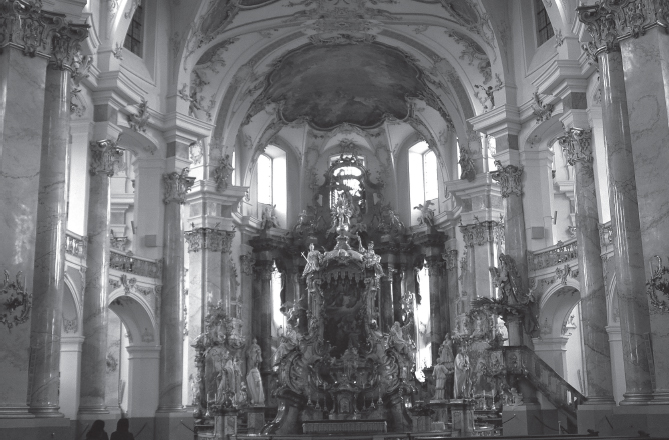
Mercy Altar, Basilica of the Fourteen Holy Helpers (also Basilika Vierzehnheiligen), 17431772. Bad Staffelstein, Germany
Modernism, Alexander Kluge observed somewhere, is our classicism, our classical antiquity. That presumes that it is over; but if so, when did it begin? It is a question, or perhaps a pseudo-question, that leads to deeper ones about modernity itself, when not about historical storytelling. I will myself begin (as one must) with an outrageous assertion, namely that modernity begins with the Council of Trent (ending in 1563)in which case the Baroque becomes the first secular age. Im sorry to say that this may not be as perverse a claim as it sounds at first: for if we inevitably associate the Baroque with the building of extraordinary churches all over the Christian world, and with an unparalleled efflorescence of religious art, there is an explanation ready to hand.
With modernity and secularization, religion falls into the realm of the social, the realm of differentiation. It becomes one world-view among others, one specialization among many: an activity to be promoted and sold on the market. In the face of Protestantism, the Church decides to advertise and to launch the first great publicity campaign on behalf of its product. After Luther, religion comes in competing brands; and Rome enters the contest practicing the usual dual strategy of carrot and stick, culture and repression, painters and architects on the one hand and generals and the Inquisition on the other. Maravalls thesisthat the Baroque is the first great deployment of a public sphere and of mass culturethereby finds its corroboration and confirmation.
But we may well want to augment this periodizing hypothesis with another, of a rather different kind. Hegel thought there
It is then plausible to assume that the end of religion is on us with secularization, and probably with Luthers revolution, which transformed a culture organized by religion into a space in which what is still called religion has become an essentially private matter and a form of subjectivity (among many others). In that case, it would follow that the apogee of art as a vehicle for the Absolute arrives in the Renaissance/Reformation period and finds its most extraordinary flowering in that century normally characterized as the Baroque, which opens with Shakespearean drama and concludes (stretching the notion of a century somewhat) with the building of Vierzehnheiligen (or maybe even with Bachs elaboration of the tonal system). The Baroque is the supreme moment of theatricality, the Elizabethans only serving as the prelude to Spanish theater (Caldern) and French classicism (not excluding the somewhat less than illustrious German playbooks cited in Walter Benjamins Trauerspiel book): but drama also includes the emergence of opera (and perhaps it will not be extravagant already to glimpse the proleptic shadow of Wagnerian music drama in those early forms).
This is an age which is poor in many of the things and experiences we take for granted; poor in images, before technical reproduction, not to speak of advertising; no radio, no newspapers, not even a bourgeoisie; poor in instrumental sounds, save for that rudimentary instrument called the human voice; poor in that rich background of continuous aesthetic sensation which makes it so hard to define art in our own society of images and spectacles, but which here is limited to the specialized and discontinuous moments of performance, of festival, of chorale, and even of sumptuous space, which in that period was still limited to churches and palaces. We have to try to imagine a time before film (and before television); a world without the novel; a world which is therefore also poor in narrative. Theatricality is thus the punctual eruption of the aesthetic in this newly secularized world whose principal excitement is the unexpected arrival of foreign mercenaries in unprotected peasant villages, which they sack most cruellyit being remembered that for Nietzsche as for Artaud long after him cruelty was an essential feature of aesthetic pleasure.
Otherwise, art in the small towns and fields of this world whose dazzling epithetbarrococauses us today to see transcendent sunbursts and an excess of richness in physical ornament and language alikeaesthetic pleasure is limited to the shock of an unexpected encounterthe abrupt flash of the vision of Caravaggios Crucifixion of St. Peter in a dim side chapel of Santa Maria del Popolo, say. We have to imagine that shock today; it will have to be an accident, the boredom of a London afternoon in the National Gallery suddenly transfixed by Rubenss immense Samson and Delilah. And indeed the whole century, the long seventeenth century is here, in the force-field between Caravaggio and Rubens, the immensity of the struggle of these narrative bodies suspended in blinding oil paint before our disbelieving eyes.
I want to examine the historical conditions of possibility of such works; but first I will read into the record a famous, or indeed, notorious aesthetic generalization by Nietzsche, which may not on the face of it seem the most obvious reference here, and indeed on the face of it would seem to result from the crossing of the wires of quite distinct interests. Indeed, this Nietzsche reference documents what I have been trying to theorize as the emergence of affect in nineteenth-century literature, an emergence of which I see him both as theorist and a symptom. His characterization of aesthetics as a physiological matter will have to suffice at this point, and the relevance of this typically nineteenth-century (or decadent) view to the seventeenth century is what will have to be defended in a moment. At any rate here is the passage I wanted to recall:

